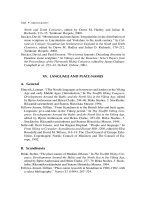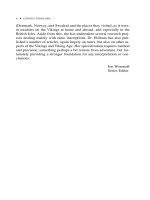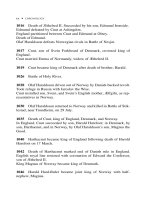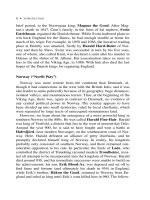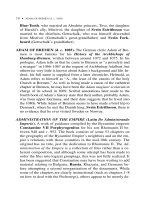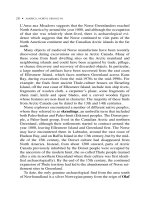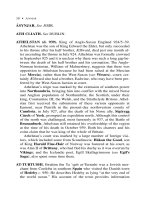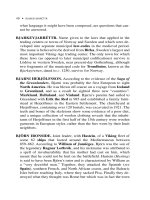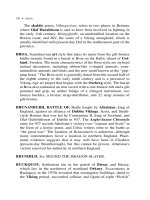The A to Z of the Vikings 16 ppsx
Bạn đang xem bản rút gọn của tài liệu. Xem và tải ngay bản đầy đủ của tài liệu tại đây (58.34 KB, 10 trang )
and Ballinbay on Islay. Evidence also seems to be accumulating for a
series of burials, including inhumations of a female and a child, at Val-
tos on Lewis. A number of rich boat burials, such as that found at
Kiloran Bay, Colonsay, and other graves containing weapons and
weighing scales have been excavated. Nevertheless, although many of
the finds suggest that the Norse population of the Hebrides was prin-
cipally made up of traders and warriors, there is some evidence of a
more settled community: Of the 32 graves where it is possible to iden-
tify the sex of the interred, there are 14 female graves.
As well as the evidence of pagan graves, 15 silver hoards of Scan-
dinavian type dating to the late 10th or early 11th century have been
recovered from North Uist, Stornaway, Dibbadale, Tiree, Iona, Inch
Kenneth, and Islay. The earliest of these is the mixed hoard of 111
Anglo-Saxon and Arabic coins and hacksilver from Storr Rock,
Skye (c. 935), but many of the hoards were deposited around the year
1000 and have been linked with the political and military dominance
of Earl Sigurd the Stout of Orkney in the Hebrides.
HEDEBY. Viking-Age town at the base of the Jutland Peninsula, just
south of the modern town of Schleswig, on an inlet of the Schleifjörd
known as Haddeby Noor. Today Hedeby lies within the borders of
Germany, but in the Viking-Age it was a Danish settlement. The
Royal Frankish Annals record that a town, Sliesthorp, was estab-
lished in 808 by the Danish king, Godfred, and this is normally iden-
tified as Hedeby. However, excavations have revealed a settlement
dating from the mid-eighth century, to the south of the area later en-
closed by the town’s ramparts. The Christian missionary, Ansgar,
established a church in the town in the 820s, during his short-lived
mission, and again when he returned in 854. A bishop of Hedeby was
consecrated by Hamburg-Bremen c. 948. During the 10th century,
Hedeby seems to have been ruled by a Swedish dynasty, known as
the Olaf dynasty, whose names are preserved in two rune-stones
from the town.
Only 5 percent of the area enclosed by the ramparts has as yet been
excavated. The main settlement of Hedeby was centered on a stream
running into Haddeby Noor. Rectangular houses, with two or three
rooms, stood at the center of regular plots of land that were marked
out by fences, ditches, or the stream. A reconstruction of a typical
128 • HEDEBY
ninth-century Hedeby house stands at Moesgård museum, near
Århus, Denmark. It is approximately 12 meters by 5 meters and is
made of a wattle-and-daub infilling around vertical wooden posts.
The outside of the house is supported by sloping timber posts. The
main room, with a long hearth in the middle, is placed centrally in
the building, with a further room at either end. Raised wooden plat-
forms, used for sleeping, line the long walls of the main room.
Hedeby was perhaps the greatest of Viking-Age towns in Scandi-
navia, and at its peak it had perhaps as many as 1,500 permanent in-
habitants. Its location meant that it was well placed for trading with
eastern and southern Europe, via the Baltic Sea. In addition to the
town, excavations have revealed extensive cemeteries surrounding it,
consisting of perhaps as many as 7,000 burials, many of which con-
tain lavish grave goods that reflect the wealth of the town. Its own sil-
ver coinage, modeled on Frisian (see Frisia) exemplars, was minted
briefly in the early ninth century; and the town provides the only
clear evidence for pottery making in Scandinavia.
However, Hedeby also suffered as a result of its location, strad-
dling the contested border between Denmark and the expanding Ger-
man empire and its wealth. The town was defended by a three-meter-
high rampart, topped by a timber palisade, in the 10th century, and
via the so-called Connecting Wall was incorporated into the
Danevirke. These defenses were later extended and improved until
the ramparts stood at 10 meters high, were 1,300 meters long, and en-
closed an area of some 24 hectares. In addition to this, a hillfort
(Hochburg) was constructed to the north of the town, and the town’s
harbor was protected by an underwater palisade. Nevertheless,
Hedeby was burned to the ground on at least two occasions, includ-
ing an assault by Harald Hard-Ruler in 1050, before its final de-
struction in 1066 by a Wendish (see Wends) force. A rune-stone from
the town preserves a unique record of one such battle for Hedeby: it
was raised by the Danish king, Svein Forkbeard, following his re-
capture of the town from an occupying force in the 11th century. One
of his retainers, Skar
ði, was killed in the campaign, and Svein com-
memorated his bravery with a runic inscription. At the end of the 11th
century, the town’s role was taken over by nearby Schleswig, where
the earliest medieval buildings to be excavated have been dated to
1071. See also AT-TURTUSHI.
HEDEBY • 129
HEIMDALL (ON Heimdallr). Norse god of the Æsir. Heimdall was
the guardian of the gods and watched over the bridge Bifrost, to
make sure that the giants did not cross it into the heavens. His hall,
Himinbjörg, was near to the bridge. According to Gylfaginning,
Heimdall was “great and holy,” was known as the “White god,” had
golden teeth, did not need much sleep, could see things a long way
away regardless of whether it was day or night, and was able to hear
the grass growing. He is said to sound his horn (Gjallarhorn) at the
beginning of Ragnarök, to warn the gods of the giants’ approach. At
Ragnarök, Heimdall and Loki are said to kill each other, and these
two gods are also said to fight over Freya’s necklace, Brísingamen.
Heimdall seems to have been an important god, but much about him
remains obscure. In Völuspá and Rígs
þþ
ula, Heimdall is said to be the
father of humankind. Heimdali and Hallinski
ð
i, one of Heimdall’s
pseudonyms, are both given as poetic alternatives to the word “ram”
in Snorri’s Skáldskaparmál, and “Heimdall’s sword” was another
word for “head,” as his sword was called Höfu
ð
(“Head”).
HEIMSKRINGLA (“Circle of the World”). A collection of sagas
about the kings of Norway composed by the Icelandic chieftain,
Snorri Sturluson, c. 1220 (although none of the existing medieval
manuscripts name him as its author). The name Heimskringla is first
recorded in the 17th century and is derived from the opening words
of the first saga in the collection, Ynglinga Saga. Before this,
Snorri’s work seems to have been known by a number of different ti-
tles, including “The Book of Kings” (Konunga bók) or “The Book of
Norwegian Kings” (Nóregskonunga bók).
After Ynglinga Saga, Heimskringla continues with 16 further
sagas, covering the period from the beginning of the Viking Age un-
der the semi-legendary Halfdan the Black to the reign of Magnus
Erlingsson, who died in 1184. Approximately a third of the work is
devoted to the 15-year reign of Olaf Haraldsson, the patron saint of
Norway. This saga of St. Olaf (Ólafs saga helga), an adaptation of the
Separate Saga of St. Olaf (see Sagas of St. Olaf), was apparently
composed first and the rest of the sagas that make up Heimskringla
written around it. The collection seems to have been extensively
copied and used by later writers, and it survives in a number of me-
dieval manuscripts and later paper copies. The oldest known manu-
130 • HEIMDALL
script, known as Kringla after the opening words Kringla heimsins
(“Circle of the World”), was written some time before 1270, but only
a single page of this has survived. There are, however, a number of
good transcripts of Kringla that form the basis of most editions
of Heimskringla.
The historical value of these Kings’ Sagas is still debated. They
were not written as modern analytical histories of the Norwegian
kings but as dramatic narratives about key political players in Nor-
way’s past. Clearly the direct speech is not authentic, and there are ref-
erences to magic, supernatural creatures, dreams, and premonitions.
Character sketches and personal descriptions were used, as in other
kinds of sagas, to illuminate the personality and motives of the indi-
vidual. Nevertheless, Snorri did take a critical approach to his sources,
placing most reliance on skaldic poetry that was generally composed
for the kings and princes during their lifetimes. These poems were, he
argued, trustworthy, as a poet would not dare to lie about a king’s
achievements in front of the whole court. Less is known about his
prose sources, particularly as many of these have not survived or ex-
ist only in later versions that appear to differ from the texts that Snorri
knew. At best, Heimskringla is a work that preserves historical fact
alongside oral tradition and literary embellishment.
HEITI. Word meaning “name,” and a technical term used by Snorri
Sturluson to refer to the poetic synonyms used by skaldic poets. To-
day, an example of a heiti in English might be the use of the word
“steed” for a horse. Snorri’s examples in Skáldskaparmál include
some of the heiti or synonyms for raven: crow, Hugin, Munin, early-
flier, and flesh-marker; for bear: cub, grizzly, snarler, greedy-tooth,
dark one, greedy one, forest-walker, and yellow bottom; and for the
sun: day-star, disc, ever-glow, all bright seen, fair wheel, Dvalin’s
toy, and grace-shine.
HEL. The world of the dead in Norse mythology and the name of the
goddess who inhabited it. Those who have died on land of old age or
illness are said to go to Hel. However, in the later medieval period,
Hel became associated with the Christian idea of hell, as a place of
punishment, and in Snorri’s Prose Edda is depicted as a cold, damp
place in the north and a place of misery and suffering.
HEL • 131
HELGI THE LEAN (ON Helgi inn magri). Son of Eyvind the East-
erner (so-called because he was brought up in Swedish Götaland)
and Rafarta, the daughter of the Irish king, Kjarval. Helgi was born
in the Hebrides and fostered there for two years before being sent to
Ireland. According to the Book of Settlements, his nickname was
given after his parents returned to the Hebrides to see how he
was; they “saw a boy there with fine eyes but no flesh on his bones,
for he was starved.” Helgi married Thorunn Hyrna, one of the daugh-
ters of the famous chieftain Ketill Flat-Nose, and they had four chil-
dren: Hrólfr, Ingvald, Ingunn, and Thorbjörg Holmasol.
The Book of Settlements contains a detailed account of the depar-
ture of Helgi and his family for Iceland. Particularly interesting is the
reference to Helgi’s consultation of the god Thor as to where he
should go ashore. Helgi made landfall in the north of Iceland, claim-
ing all of the district of Eyjafjörd between the headlands of Siglunes
and Reynisnes and, after several years, building a farmstead at
Kristnes (“Christ’s headland”). The Christian place-name and the ref-
erence to Thor provide an interesting insight to Helgi’s religious be-
liefs, and the Book of Settlements adds that although he believed in
Christ, he trusted Thor in all matters of seafaring and “for everything
that struck him as of real importance.” These beliefs must reflect
Helgi’s upbringing in the mixed Norse-Gaelic environment of the
western colonies in the ninth century.
Helgi and his family are also mentioned in a number of sagas, in-
cluding Laxdæla Saga and the Saga of Erik the Red. As well as
Helgi’s own marriage into the family of Ketill Flat-Nose, his sister,
Thurid, was married to Ketill’s grandson, Thorstein the Red (son of
Aud the Deep-Minded).
HELLULAND (“Stone- or Slab-Land”). Land sited by Leif the
Lucky Eriksson on his voyage to Vinland. According to the Saga of
the Greenlanders, Helluland was covered with glaciers, was barren,
and lay to the north of Vinland; the Saga of Erik the Red adds that
there were numerous foxes there. Following the discovery of Norse
artifacts at L’Anse aux Meadows, most scholars have identified Hel-
luland with present-day Baffin Island off the coast of Canada.
HEMMING. See HARALD KLAK.
132 • HELGI THE LEAN
HERJOLFSNES. See BJARNI HERJÓLFSSON.
HILLERSJÖ. Famous rune-stone from the parish of Hillersjö in the
central Swedish province of Uppland, about 20 kilometers south of
Sigtuna. The rune-stone was raised by a woman called Gerlög in the
11th century. The inscription provides a brief history of Gerlög’s
family: her two husbands, Germund and Gudrik; her son, who is un-
named; her daughter, Inga, who married twice, to Ragnfast and to
Erik; and her unnamed grandson. The purpose of this long and
uniquely detailed inscription seems to be to record Gerlög’s right to
the property that she inherited. The inscription does not follow the
usual Viking-Age commemorative formula and opens instead with an
exhortation to passers-by to read the text: “Read! Germund took Ger-
lög, a maiden, as wife. Then they had a son before Germund was
drowned and then the son died. Thereafter she had Gudrik as her hus-
band . . . [the inscription is damaged at this point] . . . Then they had
children but only one girl survived, her name was Inga. Ragnfast of
Snottsta had her as his wife. Thereafter he died and then the son. And
the mother (Inga) inherited from her son. Then she had Erik as her
husband. Then she died. Then Gerlög inherited from Inga her daugh-
ter. Torbjörn skald carved the runes.”
Gerlög’s daughter, Inga, built a bridge and raised four rune-stones
herself before her death, all of which commemorated her dead hus-
band, Ragnfast. These rune-stones are found in the parish of Markim,
about 20 kilometers east of Sigtuna, and testify to Inga’s wealth as
sole heiress of her father, Germund, and her son, Ragnfast’s heir. The
rules of inheritance outlined in this group of inscriptions are the same
as those found in the Uppland Law, written down in 1296.
HIRD (ON hir
ðð
from OE hired “household”). A hird was a retinue of
warriors that followed a king, prince, or chieftain in Scandinavia, and
which normally resided at the court of its king or lord. There is com-
paratively little information relating to the institution during the
Viking Age; only two rune-stones from Denmark (DR 107 from
Egå, north Jutland and DR 134 from Ravnkilde in north Jutland)
mention men who were landhir
ð
ir and hir
ð
ir respectively, translated
as “(land-)steward.” Manne from Egå was explicitly said to be in the
service of an otherwise unknown Norwegian called Ketill.
HIRD • 133
Most of the sources instead relate to the king’s hird during the me-
dieval period, particularly in Norway where the 13th-century texts,
Hir
ð
skrá and Konungs skuggsjá (“The King’s Mirror”), provide con-
siderable details about the structure of the hird. These suggest that the
hird developed from a primarily military organization into the king’s
council. By around 1270, the Norwegian hird was a three-tier organ-
ization, consisting of hir
ð
menn, gestir (“guests”) and kertisveinar
(“pages”). The first of these groups also had several different sub-
ranks that approximate to barons (lendir menn), knights (sku-
tilsveinar), and ordinary warriors (the hir
ð
menn proper). Although
rather less is known about the Danish hird, the institution did exist
there and a Law of the Hird (Vederlov) survives. This was written
down c. 1080 at the request of Archbisop Absalon and King Knut VI,
and it is claimed to derive from a law of Cnut I the Great. However,
while some of the provisions may date to the 11th century, many do
not, and this is probably an attempt to claim old authority for a
largely new set of legal provisions. Versions of the Vederlov are
found in the work of Saxo Grammaticus and Sven Aggesen. In the
12th and 13th centuries, members of the hird in Norway and Den-
mark started to move out of the king’s court and into the countryside,
as royal administrators, a process which ultimately led to the disap-
pearance of the institution.
The institution of the hird was apparently unknown in Sweden. It
only appeared in Iceland toward the middle of the 13th century,
when the Norwegian king began to exert considerable influence on
the power politics of the republic in the years before its submission
to the Norwegian king in 1262–1264.
HISTORIA DE ANTIQUITATE REGUM NORWAGENSIUM (“His-
tory of the Ancient Kings of Norway”). A summary of Norwegian
history from Harald Fine-Hair to Sigurd the Crusader (ON Sigur
ð
r
Jórsalafari, 1103–1130), although the last event mentioned took place
in 1177. This work was composed by the monk, Theodoricus, who
dedicated it to Archbishop Eysteinn Erlendsson of Trondheim. Arch-
bishop Eysteinn died in 1188, so the history was presumably written
between 1177 and 1188, which makes it one of the oldest Norwegian
histories. However, very little is known about Theodoricus,
although references to St. Hugh of the Parisian monastery of St-Victor
134 •
HISTORIA DE ANTIQUITATE REGUM NORWAGENSIUM
may suggest that he studied there. Certainly, to judge from the sources
he mentioned in his history, he had a sound classical education. He be-
moaned the lack of written Norwegian history but mentions two
sources by name: a life of Olaf Haraldsson and a now-lost Catalogus
regum Norwagiensium, a catalog of the kings of Norway. To judge
from his history, this catalog appears to have contained some details
that differed from those given in Icelandic historical sources. Theodor-
icus also mentions the oral testimony of Icelanders among his sources,
although it is not clear if he used the written histories of Sæmund the
Learned and Ari Thorgilsson.
HISTORIA NORWEGIAE. An anonymous Latin history of Norway.
The manuscript containing this account has been dated to around 1500,
but the history itself appears to have been written rather earlier—it
refers to a volcanic eruption and earthquake that happened in 1211 as
being contemporary. It includes a geographical description of Norway
and its North Atlantic colonies, as well as a history of the kings of Nor-
way from their legendary forefathers, the Ynglingar, to Olaf Haralds-
son. The manuscript in which the Historia Norwegiae is preserved is
fragmentary and its ending is lost, but the third and final section of the
history appears to have described the battle between paganism and
Christianity. The author used a wide range of sources, classical and
otherwise, which included Adam of Bremen’s History of the Arch-
bishops of Hamburg-Bremen and a lost Latin work on Norway, which
the author of Ágrip also seems to have used.
HISTORIARUM ADVERSUM PAGANOS LIBRI SEPTEM. See
SEVEN BOOKS OF HISTORY AGAINST THE PAGANS.
HISTORY OF THE ARCHBISHOPS OF HAMBURG-BREMEN.
The History of the Archbishops of Hamburg-Bremen is a work of four
volumes or books by the German cleric Adam of Bremen. The first
three books cover the history of the archbishops from the eighth cen-
tury, when they were involved in the conversion of the Saxons, right
up to the death of Adam’s patron, Archbishop Adalbart, in 1072. As
one of the first official missions to convert the North was launched
from the see of Hamburg-Bremen, this history includes important de-
tails about the archbishops’ relationship with Scandinavia and its
HISTORY OF THE ARCHBISHOPS OF HAMBURG-BREMEN
• 135
kings. In addition to this, the fourth and last book of Adam’s history
is essentially a geographical account of the Baltic, North Sea and
North Atlantic regions, as background to Hamburg-Bremen’s mis-
sions to convert the Scandinavian and Slavic peoples in these areas.
This book in particular includes many interesting details about the so-
ciety and economy of Viking-Age Scandinavia, as well as references
to the discovery and settlement of Vinland and the Norse colonies of
the North Atlantic (see Iceland and Greenland). However, Adam’s
vivid description of the sacrificial cult centered on a pagan temple at
Gamla Uppsala in Sweden is perhaps the most famous part of his
history.
Adam began work on his history after the death of his patron,
Archbishop Adalbart, in 1072, and the work was finished some three
or four years later when it was presented to Archbishop Liemar.
However, Adam continued to revise and annotate his work, and most
of the extant manuscripts of his history derive from this revised ver-
sion. In all, some 141 additions were made by Adam, and 34 of these
concern England, Denmark, Norway, Russia, and Sweden; 39
amendments were made to Book 4. No original manuscripts of
Adam’s history survive, but there are numerous copies. Three main
manuscript traditions, known as A, B, and C, exist, with A represent-
ing the version closest to that presented to Archbishop Liemar
(known as a), and thus generally lacking extensive annotations; and
B and C containing more of the later annotations and revisions,
although B has a number of errors introduced by a copyist who had
difficulty in reading Adam’s heavily annotated original (X), and the
author of C has added some of his own material.
Throughout the Viking Age, Hamburg-Bremen fought to maintain
its supremacy in Scandinavia against the threat of the English church,
and, in particular, against the archbishop of York’s attempts to estab-
lish his dominance in the region. One of Adam’s purposes in writing
his history was probably therefore to provide written support for the
claims of Hamburg-Bremen through recording the see’s earlier mis-
sionary activity in the North. Indeed, in his prologue, Adam refers to
the fact that “ancient and honorable prerogatives of your [Archbishop
Liemar’s] Church had been gravely diminished.” Adam emphasizes
the importance of oral sources in his history, and these included the
Danish king, Svein Estrithsson, who Adam probably visited in Den-
136 •
HISTORY OF THE ARCHBISHOPS OF HAMBURG-BREMEN
mark c. 1068–1069. Other sources specified by Adam include the
Life of St. Ansgar (see Ansgar, St.); classical writers and poets, such
as Virgil, Horace, Ovid, Sallust, and Cicero; and papal letters and
documents. See also CHRISTIANITY, CONVERSION TO.
HISTORY OF THE DANES. See GESTA DANORUM; SAXO GRAM-
MATICUS.
HISTORY OF THE DUKES OF NORMANDY. See WILLIAM OF
JUMIÈGES.
HJÖRUNGAVÁGR, BATTLE OF. Sea battle fought near present-day
Ålesund, on the western coast of Norway, at the end of the 10th cen-
tury. In this battle, the semilegendary Jomsvikings were defeated by
Hákon Jarl of Lade and his son Erik. Accounts of the battle are pre-
served in Snorri Sturluson’s Heimskringla, in Jómsvíkinga Saga,
and in Saxo Grammaticus’s Gesta Danorum. Although Snorri dated
the battle to 994, Saxo writes that the attack was ordered by Harald
Blue-Tooth of Denmark, which suggests a date before Harald’s death
c. 986; the battle is normally dated to the period 980–985 by modern
historians.
HLAD
–
IR. See LADE, EARLS OF.
HNEFATAFL (“King’s Table”). One of the most popular Viking-Age
board games. Judging from the discovery of gaming pieces and
boards, hnefatafl appears to have been known throughout Scandi-
navia and its colonies in the east and west. The rules of the game are
not recorded, but it was a tactical game for two players.
HÖFUD
–
LAUSN. See EGIL’S SAGA.
HOGBACK. Viking-Age stone monuments that were probably placed
over graves. Hogbacks are generally about 1.5 meters long and are
shaped like contemporary houses and halls, with curving sides and a
convex “roof” line, the latter from which they derive their name.
Many hogbacks have architectural features, such as a shingled roof,
and a large number also have three-dimensional beasts or bears that
HOGBACK • 137
